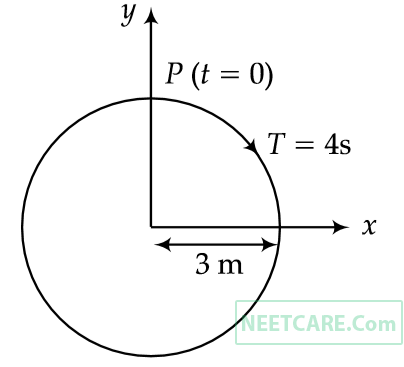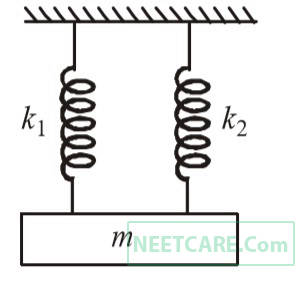Oscillations · Physics · NEET
MCQ (Single Correct Answer)
In an oscillating spring mass system, a spring is connected to a box filled with sand. As the box oscillates, sand leaks slowly out of the box vertically so that the average frequency $\omega(t)$ and average amplitude $A(t)$ of the system change with time $t$. Which one of the following options schematically depicts these changes correctly?
Two identical point masses $P$ and $Q$, suspended from two separate massless springs of spring constants $k_1$ and $k_2$, respectively, oscillate vertically. If their maximum speeds are the same, the ratio ( $A Q / A_\rho$ ) of the amplitude $A Q$ of mass $Q$ to the amplitude $A_\rho$ of mass $P$ is
A particle executing simple harmonic motion with amplitude A has the same potential and kinetic energies at the displacement
The two-dimensional motion of a particle, described by $$\vec{r}=(\hat{i}+2 \hat{j}) A \cos \omega t$$ is a/an:
A. parabolic path
B. elliptical path
C. periodic motion
D. simple harmonic motion
Choose the correct answer from the options given below:
If $$x=5 \sin \left(\pi t+\frac{\pi}{3}\right) \mathrm{m}$$ represents the motion of a particle executing simple harmonic motion, the amplitude and time period of motion, respectively, are
If the mass of the bob in a simple pendulum is increased to thrice its original mass and its length is made half its original length, then the new time period of oscillation is $$\frac{x}{2}$$ times its original time period. Then the value of $$x$$ is:
A simple pendulum oscillating in air has a period of $$\sqrt{3} \mathrm{~s}$$. If it is completely immersed in non-viscous liquid, having density $$\left(\frac{1}{4}\right)^{\text {th }}$$ of the material of the bob, the new period will be :-
The $$x$$ - $$t$$ graph of a particle performing simple harmonic motion is shown in the figure. The acceleration of the particle at $$t=2 \mathrm{~s}$$ is :

Match List-I with List-II
| List-I (x-y graphs) |
List-II (Situations) |
||
|---|---|---|---|
| (a) |  |
(i) | Total mechanical energy is conserved |
| (b) |  |
(ii) | Bob of a pendulum is oscillating under negligible air friction |
| (c) |  |
(iii) | Restoring force of a spring |
| (d) |  |
(iv) | Bob of a pendulum is oscillating along with air friction |
Choose the correct answer from the options given below
Identify the function which represents a non-periodic motion.
Two pendulums of length 121 cm and 100 cm start vibrating in phase. At some instant, the two are at their mean position in the same phase. The minimum number of vibrations of the shorter pendulum after which the two are again in phase at the mean position is :

y- projection of the radius vector of rotating particle P is :
y = A0 + A sin$$\omega $$t + B cos$$\omega $$t.
Then the amplitude of its oscillation is given by :
X = A cos$$\left( {\omega t} \right)$$
where X = displacement at time t
$$\omega $$ = frequency of oscillation
Which one of the following graphs shows correctly the variation a with t?
Here a = acceleration at time t
T = time period
(1) y = sin$$\omega $$t $$-$$ cos$$\omega $$t
(2) y = sin3$$\omega $$t
(3) y = 5cos$$\left( {{{3\pi } \over 4} - 3\omega t} \right)$$
(4) y = 1 + $$\omega $$t + $$\omega $$2t2
where k, k0, k1 and a are all positive.
When pressed slightly and released the mass executes a simple harmonic motion. The spring constant is 200 N/m. What should be the minimum amplitude of the motion so that the mass gets detached from the pan (take g = 10 m/s2).

